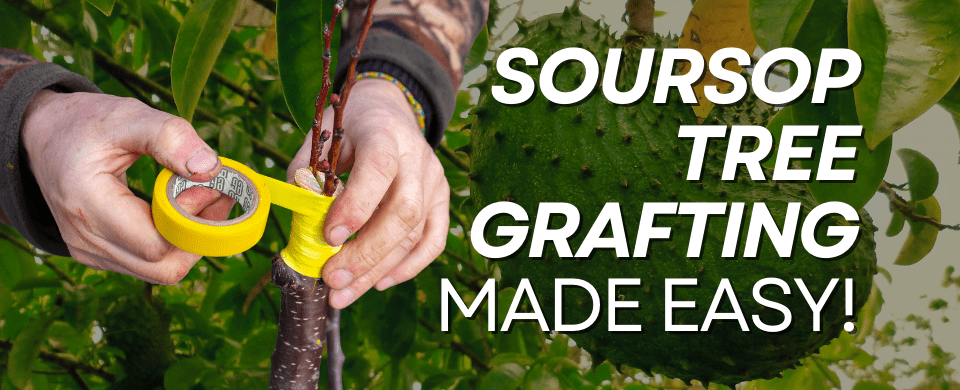
Can a Soursop Tree Be Grafted? Here’s How to Do It for Better Fruit and Faster Growth
Share
Soursop trees, also known as Annona muricata or guanábana, are tropical treasures prized for their creamy, tangy fruit and powerful health benefits. The benefits of soursop include its rich nutrient profile and potential health advantages, such as enhancing immune function and improving digestive health. Soursop is also high in vitamin C, which plays a crucial role in boosting immune health. But if you’re wondering, can a soursop tree be grafted? The answer is a resounding yes and doing so can be a game-changer for your tropical fruit garden.
Grafting soursop trees can improve fruit production, boost disease resistance, and help you enjoy fruit sooner. Whether you’re growing a soursop tree in your backyard or shopping for one at our Soursop Tree Collection, this guide will walk you through why and how to graft a soursop tree step-by-step.
In traditional medicine, soursop leaves and fruit have been used to treat various ailments, including high blood pressure and digestive health issues. Soursop extract has shown promise in reducing blood pressure and improving overall health. The tree’s disease resistance and productivity can be significantly enhanced through grafting, making it a popular choice for tropical fruit enthusiasts.

Why Graft a Soursop Tree? (Hint: Faster Fruit and Stronger Growth)
Before diving into how, let’s talk about why grafting your soursop tree is worth the effort:
- Accelerates Fruit Production: Grafted soursop trees can bear fruit in 2–3 years instead of 5–7 years from seed.
- Preserves Superior Traits: Grafting clones the genetics of a productive or flavorful mother tree.
- Improves Disease Resistance: Use a hardy rootstock to help your soursop tree thrive even in challenging conditions.
- Better Cold Tolerance: Selecting cold-hardy rootstocks gives your tropical tree a better shot in subtropical areas.
- More Compact Growth: Some grafted trees remain smaller, perfect for home gardens or container growing.
Explore other Grafted Fruit Trees and Tropical Trees in our nursery that also benefit from this technique.

Can You Graft Soursop Onto Other Trees?
Yes, but with limits. Soursop trees are part of the Annona family, so they can typically be grafted onto:
- Soursop (Annona muricata) – the most compatible and reliable.
- Cherimoya (Annona cherimola) – can be compatible but might have growth or climate limitations.
- Atemoya (hybrid of cherimoya and sugar apple) – sometimes used, but long-term success varies by region.
These combinations are more successful in tropical and subtropical zones. Compatibility and climate go hand-in-hand when it comes to grafting.

Choosing the Right Rootstock for Grafting
When it comes to grafting soursop trees, selecting the right rootstock is crucial for success. The rootstock should be compatible with the scion, which is the part of the tree that produces the fruit. Compatibility ensures that the grafted tree will grow well and produce high-quality fruit. Additionally, the rootstock should provide the necessary disease resistance and growth habits to support the scion.
While some commonly grafted plants, such as apple trees, can serve as rootstocks, it’s essential to choose a rootstock from the same species or family to ensure compatibility. For instance, a granny smith apple tree can be used as a rootstock for a soursop tree, but it’s vital to select a rootstock that is disease-resistant and has a similar growth habit. This careful selection process helps ensure the success of the grafted tree.
How to Graft a Soursop Tree: Step-by-Step Guide
Here’s a straightforward way to graft your soursop tree using the cleft grafting method, ideal for beginners and hobbyists:
✂️ What You’ll Need:
- Healthy rootstock (seedling tree around 1 year old)
- Scion wood (a fresh cutting from a mature, fruiting soursop tree)
- Sharp knife or grafting tool
- Grafting tape or rubber bands
- Grafting sealant (optional)
- Alcohol wipes or sanitizer
- Labels to mark the grafted plant
🌱 Step-by-Step Instructions:
-
Choose the right time
The best time to graft is during active growth, typically late spring or early summer when sap is flowing. -
Select a compatible rootstock
Use a strong soursop seedling or compatible Annona species that’s disease-free. The rootstock should be as thick as a pencil. -
Cut the rootstock
Trim the rootstock straight across and make a vertical cut down the center (1–2 inches deep). This is where the scion will be inserted. -
Prepare the scion
Take a healthy, pencil-thick branch with 2–3 buds. Cut the base into a wedge shape to fit into the cleft. -
Insert the scion
Fit the scion wedge into the rootstock’s cleft. Make sure the cambium layers (green layer under bark) are aligned, this is crucial for success. -
Secure it
Wrap the graft tightly with grafting tape or rubber bands to keep moisture in and air out. -
Seal it
Use a grafting sealant or melted wax to protect the exposed area from pests and disease. -
Label and monitor
Place the tree in filtered sunlight and water gently. Keep the area humid and check daily. You’ll see signs of successful grafting in 2–4 weeks, like buds swelling or new leaves.

🌿 Pro Tip: Remove any shoots from the rootstock below the graft to encourage energy flow to the grafted section.
Preparing the Scion for Grafting
Preparing the scion for grafting involves selecting a young shoot or bud from a parent tree, typically in early spring. The scion should be cut at a 45-degree angle to create a clean, smooth surface that will fit well with the rootstock. To prevent moisture loss and protect the delicate tissues, the cut surface should be treated with grafting wax.
Handling the scion with care is essential to avoid damaging the tissues. Once prepared, the scion should be grafted onto the rootstock using a suitable grafting technique, such as cleft grafting or inlay grafting. The graft should be secured with grafting tape or a rubber band to ensure a tight fit and promote successful union.
The Science Behind Grafting: How It Works
When a graft is successful, the scion and rootstock join at their cambium layers, forming a vascular connection. This allows water, nutrients, and hormones to flow between them as one plant. Over time, the graft union strengthens, and the two become a single growing tree.
This is why clean cuts, proper alignment, and sterile tools are so important. A poorly aligned graft may never unite, leaving you with a failed attempt.
Best Practices for Grafting Success
To boost your chances of a successful graft, keep these tips in mind:
- Sterilize your tools before and after each cut.
- Use fresh, viable scion wood, it should bend without snapping.
- Avoid grafting in windy or cold conditions. Calm, warm weather is ideal.
- Hydrate the tree before and after grafting.
- Label your grafts with dates and plant types.
If you're new to grafting, practice on multiple trees. Even experienced growers sometimes have failures so don’t be discouraged.

Common Challenges in Grafting
Grafting soursop trees can present several challenges, but understanding these issues can help you overcome them. One of the most significant challenges is ensuring compatibility between the scion and rootstock. Incompatible grafts can lead to reduced growth or even the death of the tree.
Another common challenge is preventing disease and pests from infecting the graft. Using grafting wax and maintaining good hygiene practices can help protect the graft from these threats. Additionally, grafting involves making precise cuts, which can be difficult to master, especially for beginners. Using a sharp knife and making clean, smooth cuts are crucial for successful grafting.
What to Expect After Grafting Your Soursop Tree
You might be wondering, "Now what?"
Here’s what to expect in the weeks and months following your graft:
Week 1–3:
- Keep the tree in partial shade
- Monitor for swelling buds or signs of new growth
- Ensure the graft remains wrapped and sealed
Month 1–2:
- Begin slowly removing the grafting tape if new leaves are present
- Prune away any suckers or rootstock growth
Month 3–6:
- Begin training the young tree
- Stake the plant if needed to keep the graft upright
By the end of the first year, your grafted tree should be on its way to establishing a strong central leader and forming a canopy. Grafted soursop trees can start flowering in as little as two to three years under ideal conditions.

Should You Buy a Grafted Soursop Tree Instead?
Yes, if you're not ready to try grafting yourself, you can still enjoy the benefits. At Everglades Farm, we offer high-quality, grafted soursop trees grown for flavor, yield, and resilience.
These trees are ready to plant and grow faster than seedlings, making them ideal for gardeners looking for results.
How to Care for a Grafted Soursop Tree
Once your grafted tree is established, it still needs regular care to thrive. Here’s what you should focus on:
🌞 Sunlight
- Full sun is best 6–8 hours daily
☔️ Watering
- Water deeply when the top 2 inches of soil dry out
- Avoid soggy roots – soursops hate "wet feet"
🌾 Soil
- Well-draining and slightly acidic
- Ideal pH: 5.5 to 6.5
🌱 Fertilizing
- Apply organic fertilizer every 4–6 weeks during spring and summer
🌿 Mulching
- Apply 2–3 inches of organic mulch to conserve moisture and suppress weeds
For more help with tree care, check out our blog: How to Grow a Soursop Tree
Related FAQs About Grafting Soursop Trees
Can I graft soursop during winter?
No. Grafting is most successful during the warm, active growing season, preferably spring through mid-summer.
What is the success rate of soursop grafting?
With proper technique, success rates range from 60% to 90%, depending on climate and compatibility.
Can I graft multiple varieties onto one tree?
Yes! With skill and patience, you can grow multiple Annona fruits on a single rootstock.
What’s the difference between a grafted tree and a seedling tree?
Grafted trees are clones of a known parent tree and bear fruit sooner. Seedlings may take longer and produce unpredictable fruit.
Should You Graft Your Soursop Tree?
If you want faster fruit, stronger trees, and more reliable harvests, grafting is the way to go. With a bit of patience and care, even beginner gardeners can pull it off.
📍 Browse our full Soursop Collection or explore Grafted Fruit Trees to start your tropical gardening journey.
Don’t forget to bookmark this guide and share it with fellow fruit tree lovers! If you have questions or want to show off your grafting progress, tag us or drop us a message. We’re always here to help you grow.

